HNHS 108 - Sociological Context of Health & Social Care Analysis
VerifiedAdded on 2023/06/12
|11
|4527
|437
Report
AI Summary
This report delves into the sociological context of health and social care, examining how political, social, and economic constructs categorize society, reviewing current trends in societal change and their impact on social expectations, and discussing the influence of cultural values and beliefs. It analyzes social inequalities, utilizing data to explain disparities in health and social care, and evaluates the implications of societal change for the health and social care sector. The report further explores how social inequalities influence life chances and health status, referencing key reports like the Black Report and the Acheson Report, and discusses the unequal distribution of opportunities and resources. It emphasizes the importance of cultural diversity in society and its impact on healthcare delivery, highlighting the need for culturally sensitive and need-based health and social care facilities to address inequalities and discrimination.
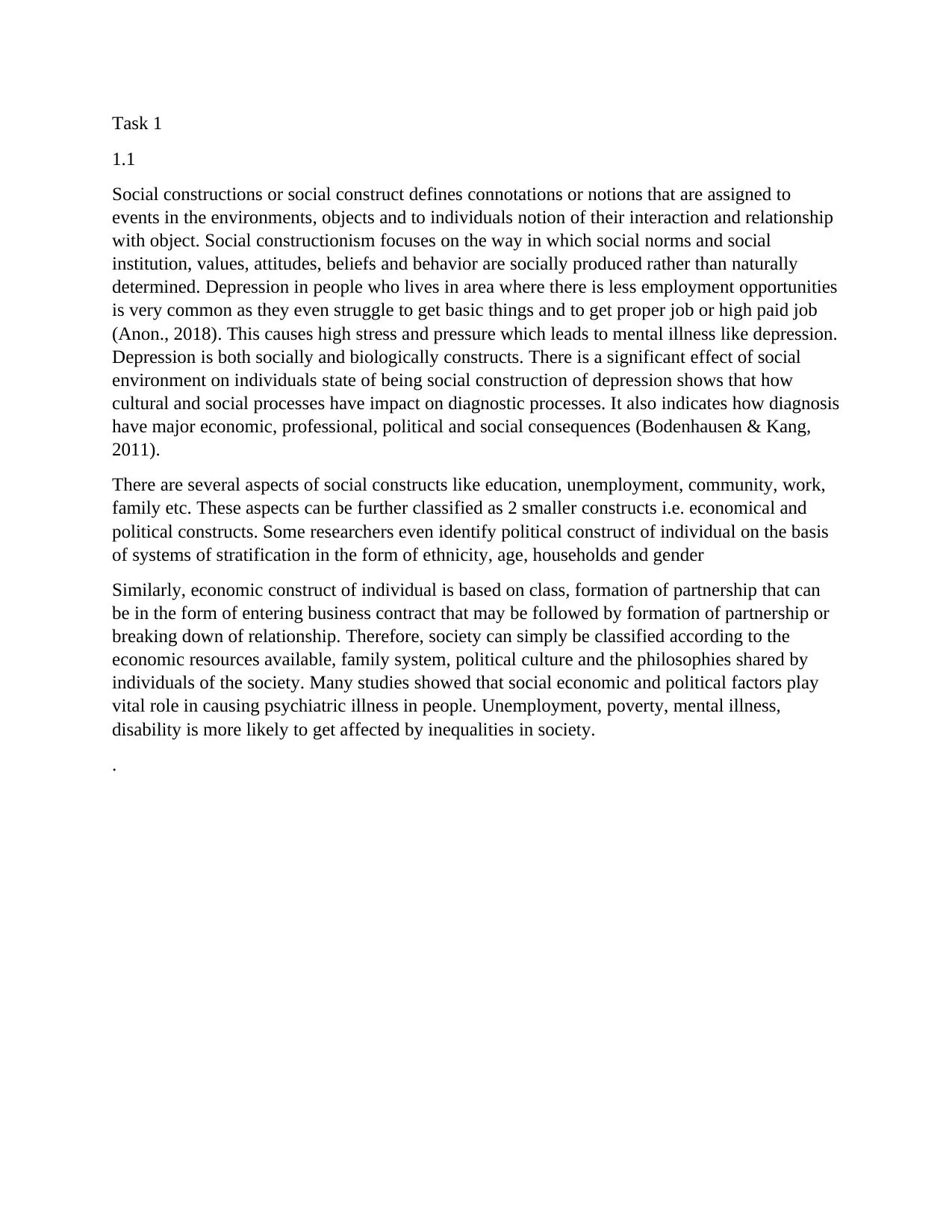
Task 1
1.1
Social constructions or social construct defines connotations or notions that are assigned to
events in the environments, objects and to individuals notion of their interaction and relationship
with object. Social constructionism focuses on the way in which social norms and social
institution, values, attitudes, beliefs and behavior are socially produced rather than naturally
determined. Depression in people who lives in area where there is less employment opportunities
is very common as they even struggle to get basic things and to get proper job or high paid job
(Anon., 2018). This causes high stress and pressure which leads to mental illness like depression.
Depression is both socially and biologically constructs. There is a significant effect of social
environment on individuals state of being social construction of depression shows that how
cultural and social processes have impact on diagnostic processes. It also indicates how diagnosis
have major economic, professional, political and social consequences (Bodenhausen & Kang,
2011).
There are several aspects of social constructs like education, unemployment, community, work,
family etc. These aspects can be further classified as 2 smaller constructs i.e. economical and
political constructs. Some researchers even identify political construct of individual on the basis
of systems of stratification in the form of ethnicity, age, households and gender
Similarly, economic construct of individual is based on class, formation of partnership that can
be in the form of entering business contract that may be followed by formation of partnership or
breaking down of relationship. Therefore, society can simply be classified according to the
economic resources available, family system, political culture and the philosophies shared by
individuals of the society. Many studies showed that social economic and political factors play
vital role in causing psychiatric illness in people. Unemployment, poverty, mental illness,
disability is more likely to get affected by inequalities in society.
.
1.1
Social constructions or social construct defines connotations or notions that are assigned to
events in the environments, objects and to individuals notion of their interaction and relationship
with object. Social constructionism focuses on the way in which social norms and social
institution, values, attitudes, beliefs and behavior are socially produced rather than naturally
determined. Depression in people who lives in area where there is less employment opportunities
is very common as they even struggle to get basic things and to get proper job or high paid job
(Anon., 2018). This causes high stress and pressure which leads to mental illness like depression.
Depression is both socially and biologically constructs. There is a significant effect of social
environment on individuals state of being social construction of depression shows that how
cultural and social processes have impact on diagnostic processes. It also indicates how diagnosis
have major economic, professional, political and social consequences (Bodenhausen & Kang,
2011).
There are several aspects of social constructs like education, unemployment, community, work,
family etc. These aspects can be further classified as 2 smaller constructs i.e. economical and
political constructs. Some researchers even identify political construct of individual on the basis
of systems of stratification in the form of ethnicity, age, households and gender
Similarly, economic construct of individual is based on class, formation of partnership that can
be in the form of entering business contract that may be followed by formation of partnership or
breaking down of relationship. Therefore, society can simply be classified according to the
economic resources available, family system, political culture and the philosophies shared by
individuals of the society. Many studies showed that social economic and political factors play
vital role in causing psychiatric illness in people. Unemployment, poverty, mental illness,
disability is more likely to get affected by inequalities in society.
.
Paraphrase This Document
Need a fresh take? Get an instant paraphrase of this document with our AI Paraphraser
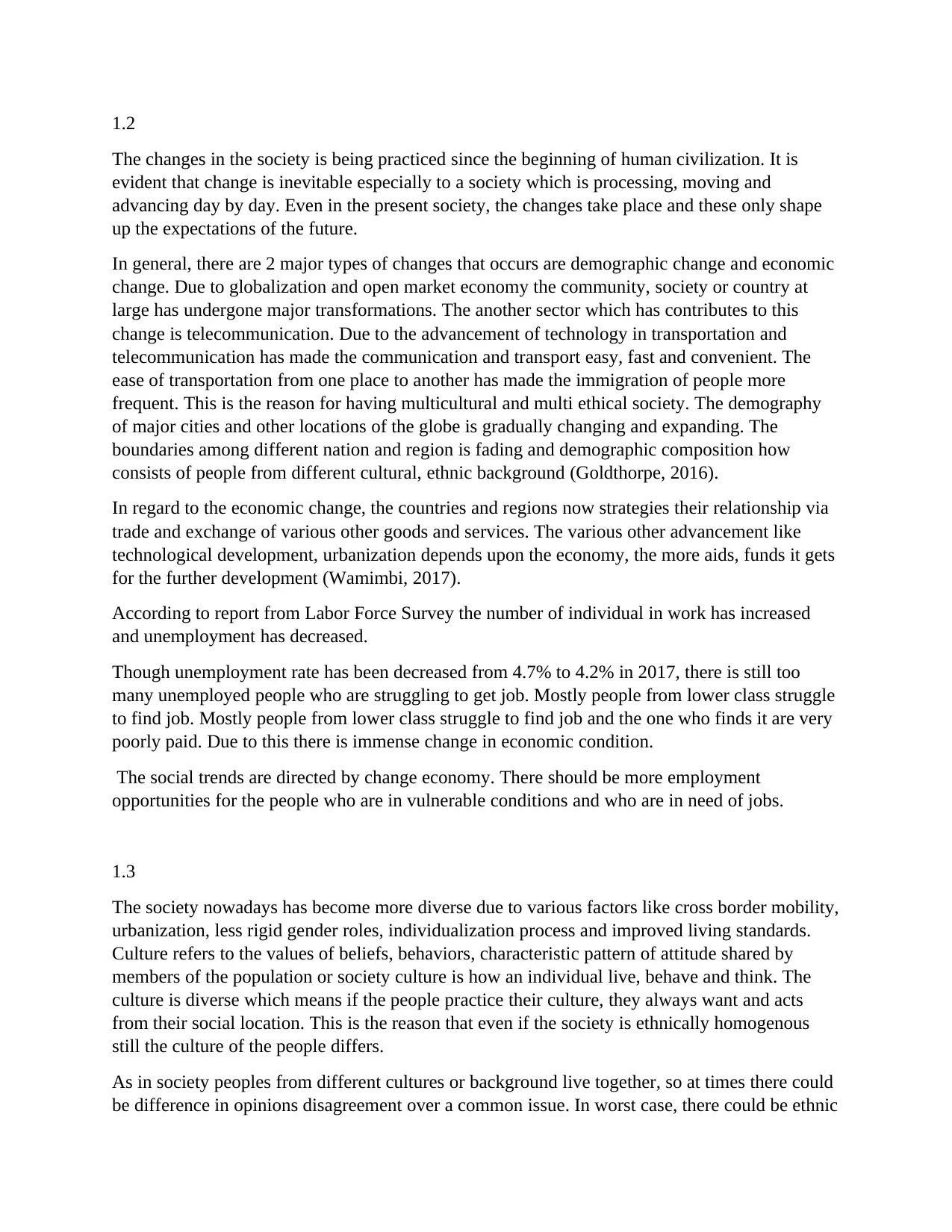
1.2
The changes in the society is being practiced since the beginning of human civilization. It is
evident that change is inevitable especially to a society which is processing, moving and
advancing day by day. Even in the present society, the changes take place and these only shape
up the expectations of the future.
In general, there are 2 major types of changes that occurs are demographic change and economic
change. Due to globalization and open market economy the community, society or country at
large has undergone major transformations. The another sector which has contributes to this
change is telecommunication. Due to the advancement of technology in transportation and
telecommunication has made the communication and transport easy, fast and convenient. The
ease of transportation from one place to another has made the immigration of people more
frequent. This is the reason for having multicultural and multi ethical society. The demography
of major cities and other locations of the globe is gradually changing and expanding. The
boundaries among different nation and region is fading and demographic composition how
consists of people from different cultural, ethnic background (Goldthorpe, 2016).
In regard to the economic change, the countries and regions now strategies their relationship via
trade and exchange of various other goods and services. The various other advancement like
technological development, urbanization depends upon the economy, the more aids, funds it gets
for the further development (Wamimbi, 2017).
According to report from Labor Force Survey the number of individual in work has increased
and unemployment has decreased.
Though unemployment rate has been decreased from 4.7% to 4.2% in 2017, there is still too
many unemployed people who are struggling to get job. Mostly people from lower class struggle
to find job. Mostly people from lower class struggle to find job and the one who finds it are very
poorly paid. Due to this there is immense change in economic condition.
The social trends are directed by change economy. There should be more employment
opportunities for the people who are in vulnerable conditions and who are in need of jobs.
1.3
The society nowadays has become more diverse due to various factors like cross border mobility,
urbanization, less rigid gender roles, individualization process and improved living standards.
Culture refers to the values of beliefs, behaviors, characteristic pattern of attitude shared by
members of the population or society culture is how an individual live, behave and think. The
culture is diverse which means if the people practice their culture, they always want and acts
from their social location. This is the reason that even if the society is ethnically homogenous
still the culture of the people differs.
As in society peoples from different cultures or background live together, so at times there could
be difference in opinions disagreement over a common issue. In worst case, there could be ethnic
The changes in the society is being practiced since the beginning of human civilization. It is
evident that change is inevitable especially to a society which is processing, moving and
advancing day by day. Even in the present society, the changes take place and these only shape
up the expectations of the future.
In general, there are 2 major types of changes that occurs are demographic change and economic
change. Due to globalization and open market economy the community, society or country at
large has undergone major transformations. The another sector which has contributes to this
change is telecommunication. Due to the advancement of technology in transportation and
telecommunication has made the communication and transport easy, fast and convenient. The
ease of transportation from one place to another has made the immigration of people more
frequent. This is the reason for having multicultural and multi ethical society. The demography
of major cities and other locations of the globe is gradually changing and expanding. The
boundaries among different nation and region is fading and demographic composition how
consists of people from different cultural, ethnic background (Goldthorpe, 2016).
In regard to the economic change, the countries and regions now strategies their relationship via
trade and exchange of various other goods and services. The various other advancement like
technological development, urbanization depends upon the economy, the more aids, funds it gets
for the further development (Wamimbi, 2017).
According to report from Labor Force Survey the number of individual in work has increased
and unemployment has decreased.
Though unemployment rate has been decreased from 4.7% to 4.2% in 2017, there is still too
many unemployed people who are struggling to get job. Mostly people from lower class struggle
to find job. Mostly people from lower class struggle to find job and the one who finds it are very
poorly paid. Due to this there is immense change in economic condition.
The social trends are directed by change economy. There should be more employment
opportunities for the people who are in vulnerable conditions and who are in need of jobs.
1.3
The society nowadays has become more diverse due to various factors like cross border mobility,
urbanization, less rigid gender roles, individualization process and improved living standards.
Culture refers to the values of beliefs, behaviors, characteristic pattern of attitude shared by
members of the population or society culture is how an individual live, behave and think. The
culture is diverse which means if the people practice their culture, they always want and acts
from their social location. This is the reason that even if the society is ethnically homogenous
still the culture of the people differs.
As in society peoples from different cultures or background live together, so at times there could
be difference in opinions disagreement over a common issue. In worst case, there could be ethnic
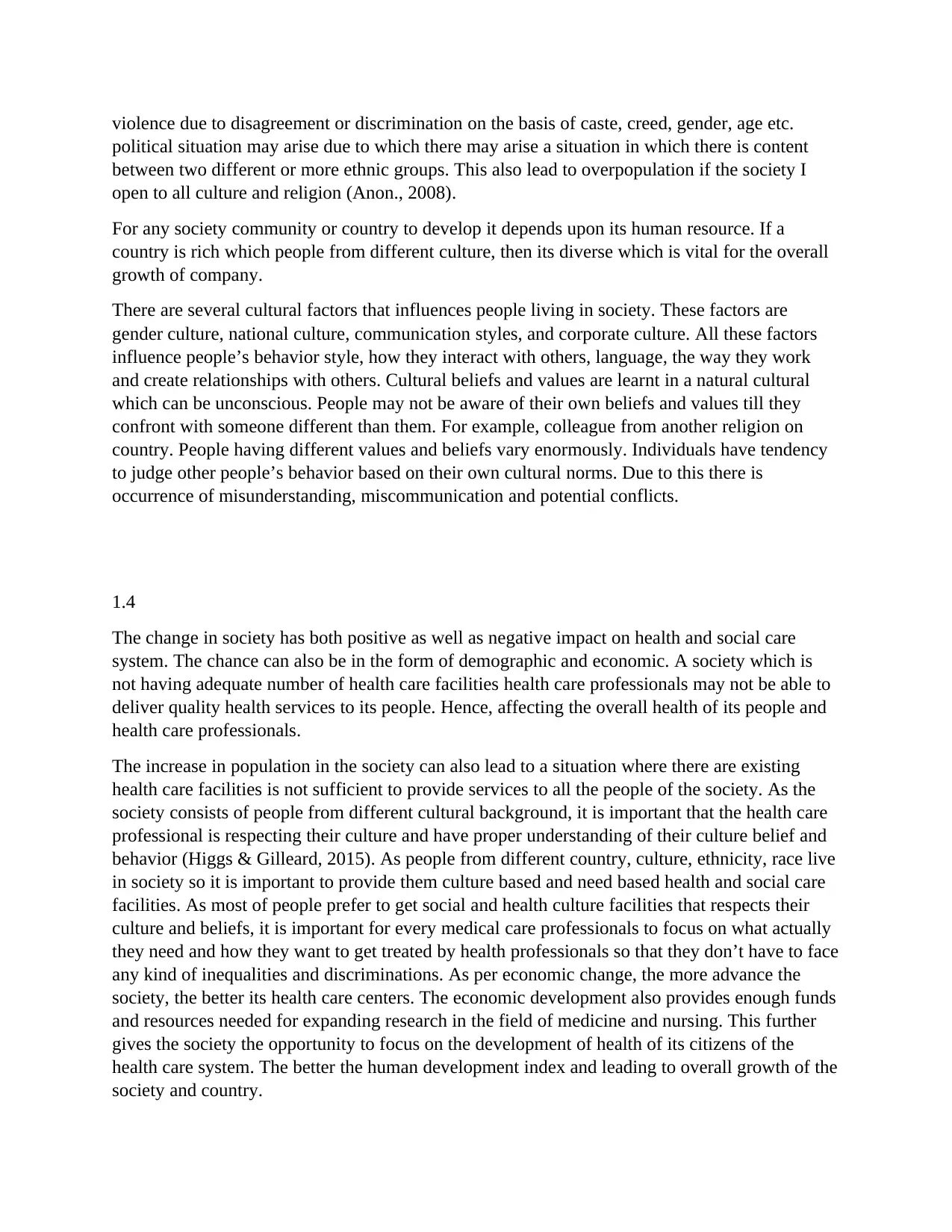
violence due to disagreement or discrimination on the basis of caste, creed, gender, age etc.
political situation may arise due to which there may arise a situation in which there is content
between two different or more ethnic groups. This also lead to overpopulation if the society I
open to all culture and religion (Anon., 2008).
For any society community or country to develop it depends upon its human resource. If a
country is rich which people from different culture, then its diverse which is vital for the overall
growth of company.
There are several cultural factors that influences people living in society. These factors are
gender culture, national culture, communication styles, and corporate culture. All these factors
influence people’s behavior style, how they interact with others, language, the way they work
and create relationships with others. Cultural beliefs and values are learnt in a natural cultural
which can be unconscious. People may not be aware of their own beliefs and values till they
confront with someone different than them. For example, colleague from another religion on
country. People having different values and beliefs vary enormously. Individuals have tendency
to judge other people’s behavior based on their own cultural norms. Due to this there is
occurrence of misunderstanding, miscommunication and potential conflicts.
1.4
The change in society has both positive as well as negative impact on health and social care
system. The chance can also be in the form of demographic and economic. A society which is
not having adequate number of health care facilities health care professionals may not be able to
deliver quality health services to its people. Hence, affecting the overall health of its people and
health care professionals.
The increase in population in the society can also lead to a situation where there are existing
health care facilities is not sufficient to provide services to all the people of the society. As the
society consists of people from different cultural background, it is important that the health care
professional is respecting their culture and have proper understanding of their culture belief and
behavior (Higgs & Gilleard, 2015). As people from different country, culture, ethnicity, race live
in society so it is important to provide them culture based and need based health and social care
facilities. As most of people prefer to get social and health culture facilities that respects their
culture and beliefs, it is important for every medical care professionals to focus on what actually
they need and how they want to get treated by health professionals so that they don’t have to face
any kind of inequalities and discriminations. As per economic change, the more advance the
society, the better its health care centers. The economic development also provides enough funds
and resources needed for expanding research in the field of medicine and nursing. This further
gives the society the opportunity to focus on the development of health of its citizens of the
health care system. The better the human development index and leading to overall growth of the
society and country.
political situation may arise due to which there may arise a situation in which there is content
between two different or more ethnic groups. This also lead to overpopulation if the society I
open to all culture and religion (Anon., 2008).
For any society community or country to develop it depends upon its human resource. If a
country is rich which people from different culture, then its diverse which is vital for the overall
growth of company.
There are several cultural factors that influences people living in society. These factors are
gender culture, national culture, communication styles, and corporate culture. All these factors
influence people’s behavior style, how they interact with others, language, the way they work
and create relationships with others. Cultural beliefs and values are learnt in a natural cultural
which can be unconscious. People may not be aware of their own beliefs and values till they
confront with someone different than them. For example, colleague from another religion on
country. People having different values and beliefs vary enormously. Individuals have tendency
to judge other people’s behavior based on their own cultural norms. Due to this there is
occurrence of misunderstanding, miscommunication and potential conflicts.
1.4
The change in society has both positive as well as negative impact on health and social care
system. The chance can also be in the form of demographic and economic. A society which is
not having adequate number of health care facilities health care professionals may not be able to
deliver quality health services to its people. Hence, affecting the overall health of its people and
health care professionals.
The increase in population in the society can also lead to a situation where there are existing
health care facilities is not sufficient to provide services to all the people of the society. As the
society consists of people from different cultural background, it is important that the health care
professional is respecting their culture and have proper understanding of their culture belief and
behavior (Higgs & Gilleard, 2015). As people from different country, culture, ethnicity, race live
in society so it is important to provide them culture based and need based health and social care
facilities. As most of people prefer to get social and health culture facilities that respects their
culture and beliefs, it is important for every medical care professionals to focus on what actually
they need and how they want to get treated by health professionals so that they don’t have to face
any kind of inequalities and discriminations. As per economic change, the more advance the
society, the better its health care centers. The economic development also provides enough funds
and resources needed for expanding research in the field of medicine and nursing. This further
gives the society the opportunity to focus on the development of health of its citizens of the
health care system. The better the human development index and leading to overall growth of the
society and country.
⊘ This is a preview!⊘
Do you want full access?
Subscribe today to unlock all pages.

Trusted by 1+ million students worldwide
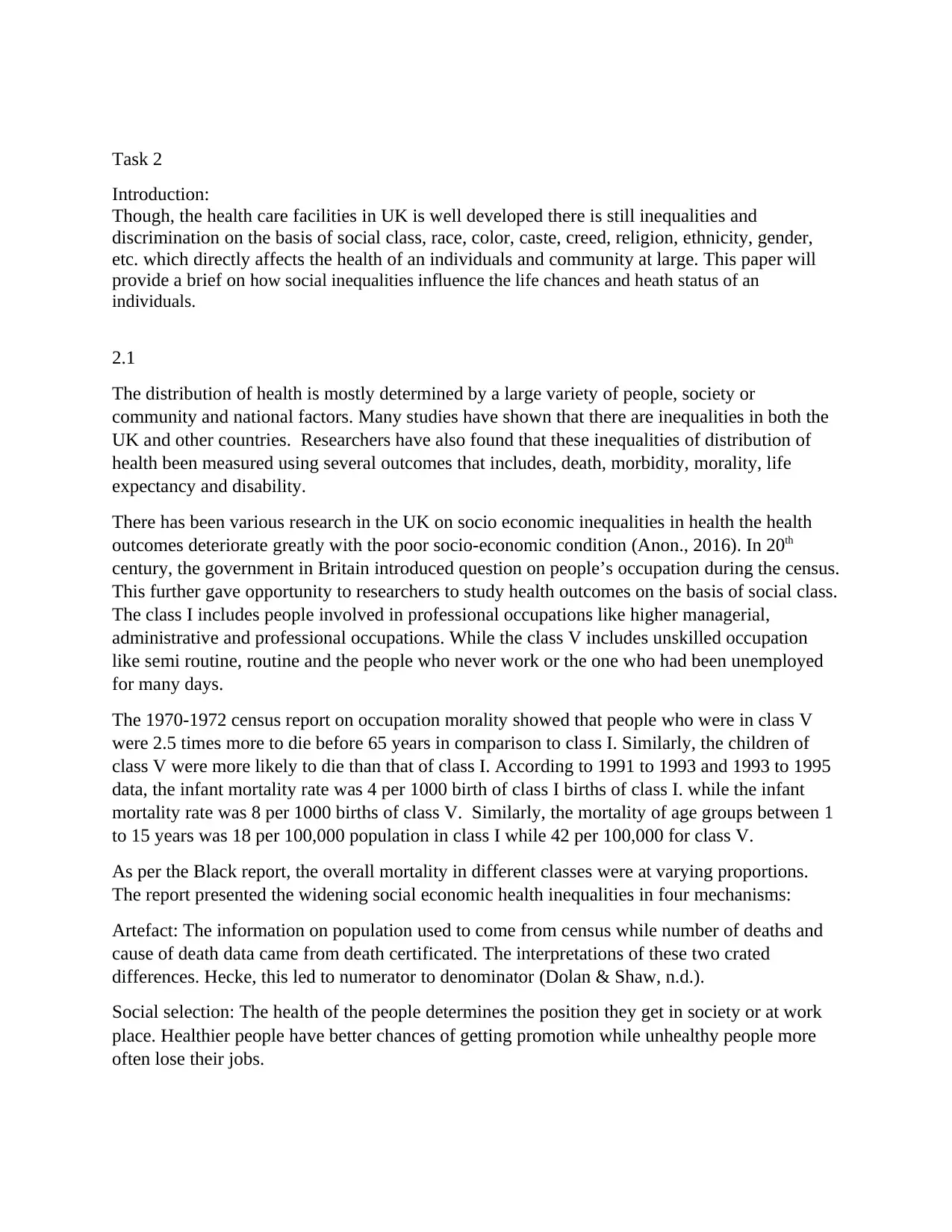
Task 2
Introduction:
Though, the health care facilities in UK is well developed there is still inequalities and
discrimination on the basis of social class, race, color, caste, creed, religion, ethnicity, gender,
etc. which directly affects the health of an individuals and community at large. This paper will
provide a brief on how social inequalities influence the life chances and heath status of an
individuals.
2.1
The distribution of health is mostly determined by a large variety of people, society or
community and national factors. Many studies have shown that there are inequalities in both the
UK and other countries. Researchers have also found that these inequalities of distribution of
health been measured using several outcomes that includes, death, morbidity, morality, life
expectancy and disability.
There has been various research in the UK on socio economic inequalities in health the health
outcomes deteriorate greatly with the poor socio-economic condition (Anon., 2016). In 20th
century, the government in Britain introduced question on people’s occupation during the census.
This further gave opportunity to researchers to study health outcomes on the basis of social class.
The class I includes people involved in professional occupations like higher managerial,
administrative and professional occupations. While the class V includes unskilled occupation
like semi routine, routine and the people who never work or the one who had been unemployed
for many days.
The 1970-1972 census report on occupation morality showed that people who were in class V
were 2.5 times more to die before 65 years in comparison to class I. Similarly, the children of
class V were more likely to die than that of class I. According to 1991 to 1993 and 1993 to 1995
data, the infant mortality rate was 4 per 1000 birth of class I births of class I. while the infant
mortality rate was 8 per 1000 births of class V. Similarly, the mortality of age groups between 1
to 15 years was 18 per 100,000 population in class I while 42 per 100,000 for class V.
As per the Black report, the overall mortality in different classes were at varying proportions.
The report presented the widening social economic health inequalities in four mechanisms:
Artefact: The information on population used to come from census while number of deaths and
cause of death data came from death certificated. The interpretations of these two crated
differences. Hecke, this led to numerator to denominator (Dolan & Shaw, n.d.).
Social selection: The health of the people determines the position they get in society or at work
place. Healthier people have better chances of getting promotion while unhealthy people more
often lose their jobs.
Introduction:
Though, the health care facilities in UK is well developed there is still inequalities and
discrimination on the basis of social class, race, color, caste, creed, religion, ethnicity, gender,
etc. which directly affects the health of an individuals and community at large. This paper will
provide a brief on how social inequalities influence the life chances and heath status of an
individuals.
2.1
The distribution of health is mostly determined by a large variety of people, society or
community and national factors. Many studies have shown that there are inequalities in both the
UK and other countries. Researchers have also found that these inequalities of distribution of
health been measured using several outcomes that includes, death, morbidity, morality, life
expectancy and disability.
There has been various research in the UK on socio economic inequalities in health the health
outcomes deteriorate greatly with the poor socio-economic condition (Anon., 2016). In 20th
century, the government in Britain introduced question on people’s occupation during the census.
This further gave opportunity to researchers to study health outcomes on the basis of social class.
The class I includes people involved in professional occupations like higher managerial,
administrative and professional occupations. While the class V includes unskilled occupation
like semi routine, routine and the people who never work or the one who had been unemployed
for many days.
The 1970-1972 census report on occupation morality showed that people who were in class V
were 2.5 times more to die before 65 years in comparison to class I. Similarly, the children of
class V were more likely to die than that of class I. According to 1991 to 1993 and 1993 to 1995
data, the infant mortality rate was 4 per 1000 birth of class I births of class I. while the infant
mortality rate was 8 per 1000 births of class V. Similarly, the mortality of age groups between 1
to 15 years was 18 per 100,000 population in class I while 42 per 100,000 for class V.
As per the Black report, the overall mortality in different classes were at varying proportions.
The report presented the widening social economic health inequalities in four mechanisms:
Artefact: The information on population used to come from census while number of deaths and
cause of death data came from death certificated. The interpretations of these two crated
differences. Hecke, this led to numerator to denominator (Dolan & Shaw, n.d.).
Social selection: The health of the people determines the position they get in society or at work
place. Healthier people have better chances of getting promotion while unhealthy people more
often lose their jobs.
Paraphrase This Document
Need a fresh take? Get an instant paraphrase of this document with our AI Paraphraser
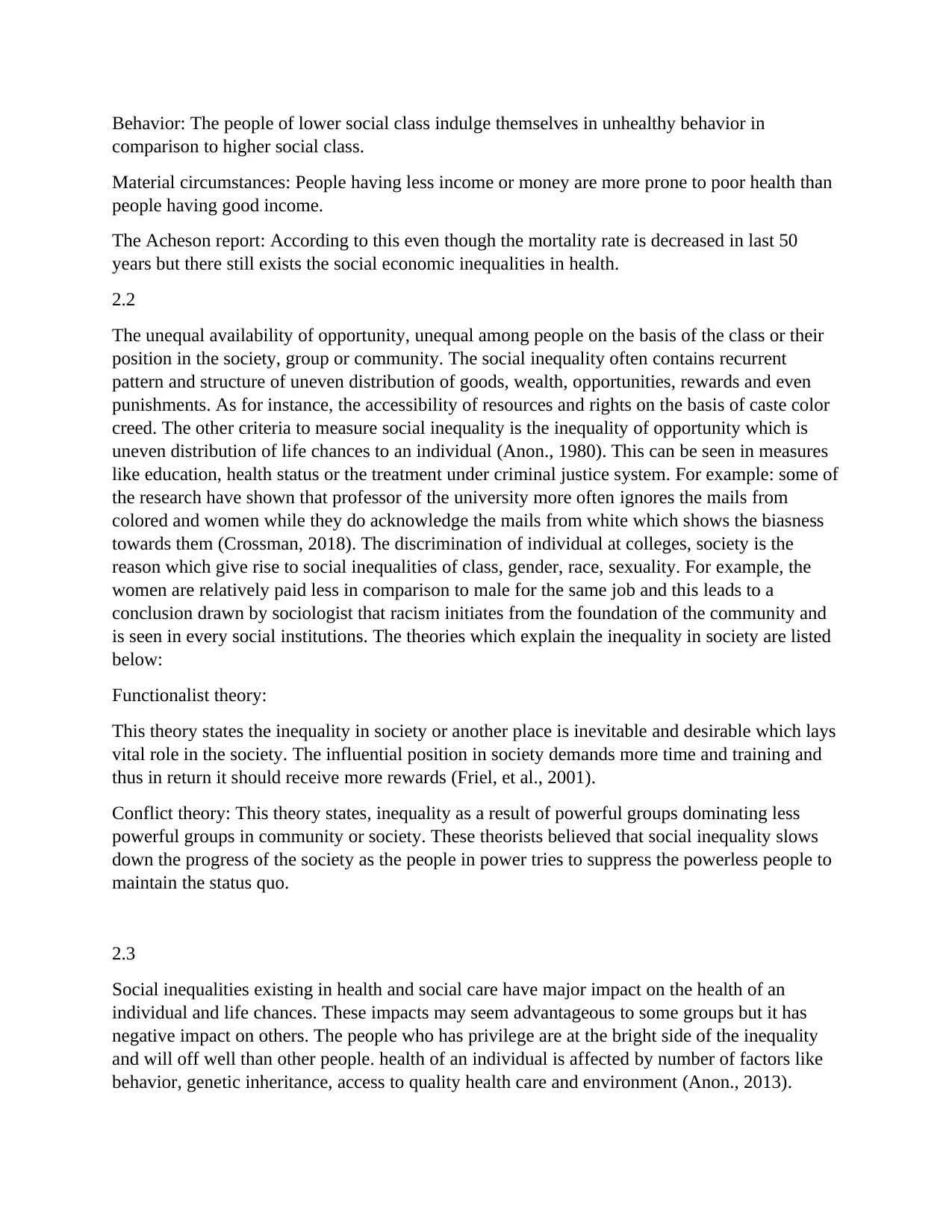
Behavior: The people of lower social class indulge themselves in unhealthy behavior in
comparison to higher social class.
Material circumstances: People having less income or money are more prone to poor health than
people having good income.
The Acheson report: According to this even though the mortality rate is decreased in last 50
years but there still exists the social economic inequalities in health.
2.2
The unequal availability of opportunity, unequal among people on the basis of the class or their
position in the society, group or community. The social inequality often contains recurrent
pattern and structure of uneven distribution of goods, wealth, opportunities, rewards and even
punishments. As for instance, the accessibility of resources and rights on the basis of caste color
creed. The other criteria to measure social inequality is the inequality of opportunity which is
uneven distribution of life chances to an individual (Anon., 1980). This can be seen in measures
like education, health status or the treatment under criminal justice system. For example: some of
the research have shown that professor of the university more often ignores the mails from
colored and women while they do acknowledge the mails from white which shows the biasness
towards them (Crossman, 2018). The discrimination of individual at colleges, society is the
reason which give rise to social inequalities of class, gender, race, sexuality. For example, the
women are relatively paid less in comparison to male for the same job and this leads to a
conclusion drawn by sociologist that racism initiates from the foundation of the community and
is seen in every social institutions. The theories which explain the inequality in society are listed
below:
Functionalist theory:
This theory states the inequality in society or another place is inevitable and desirable which lays
vital role in the society. The influential position in society demands more time and training and
thus in return it should receive more rewards (Friel, et al., 2001).
Conflict theory: This theory states, inequality as a result of powerful groups dominating less
powerful groups in community or society. These theorists believed that social inequality slows
down the progress of the society as the people in power tries to suppress the powerless people to
maintain the status quo.
2.3
Social inequalities existing in health and social care have major impact on the health of an
individual and life chances. These impacts may seem advantageous to some groups but it has
negative impact on others. The people who has privilege are at the bright side of the inequality
and will off well than other people. health of an individual is affected by number of factors like
behavior, genetic inheritance, access to quality health care and environment (Anon., 2013).
comparison to higher social class.
Material circumstances: People having less income or money are more prone to poor health than
people having good income.
The Acheson report: According to this even though the mortality rate is decreased in last 50
years but there still exists the social economic inequalities in health.
2.2
The unequal availability of opportunity, unequal among people on the basis of the class or their
position in the society, group or community. The social inequality often contains recurrent
pattern and structure of uneven distribution of goods, wealth, opportunities, rewards and even
punishments. As for instance, the accessibility of resources and rights on the basis of caste color
creed. The other criteria to measure social inequality is the inequality of opportunity which is
uneven distribution of life chances to an individual (Anon., 1980). This can be seen in measures
like education, health status or the treatment under criminal justice system. For example: some of
the research have shown that professor of the university more often ignores the mails from
colored and women while they do acknowledge the mails from white which shows the biasness
towards them (Crossman, 2018). The discrimination of individual at colleges, society is the
reason which give rise to social inequalities of class, gender, race, sexuality. For example, the
women are relatively paid less in comparison to male for the same job and this leads to a
conclusion drawn by sociologist that racism initiates from the foundation of the community and
is seen in every social institutions. The theories which explain the inequality in society are listed
below:
Functionalist theory:
This theory states the inequality in society or another place is inevitable and desirable which lays
vital role in the society. The influential position in society demands more time and training and
thus in return it should receive more rewards (Friel, et al., 2001).
Conflict theory: This theory states, inequality as a result of powerful groups dominating less
powerful groups in community or society. These theorists believed that social inequality slows
down the progress of the society as the people in power tries to suppress the powerless people to
maintain the status quo.
2.3
Social inequalities existing in health and social care have major impact on the health of an
individual and life chances. These impacts may seem advantageous to some groups but it has
negative impact on others. The people who has privilege are at the bright side of the inequality
and will off well than other people. health of an individual is affected by number of factors like
behavior, genetic inheritance, access to quality health care and environment (Anon., 2013).
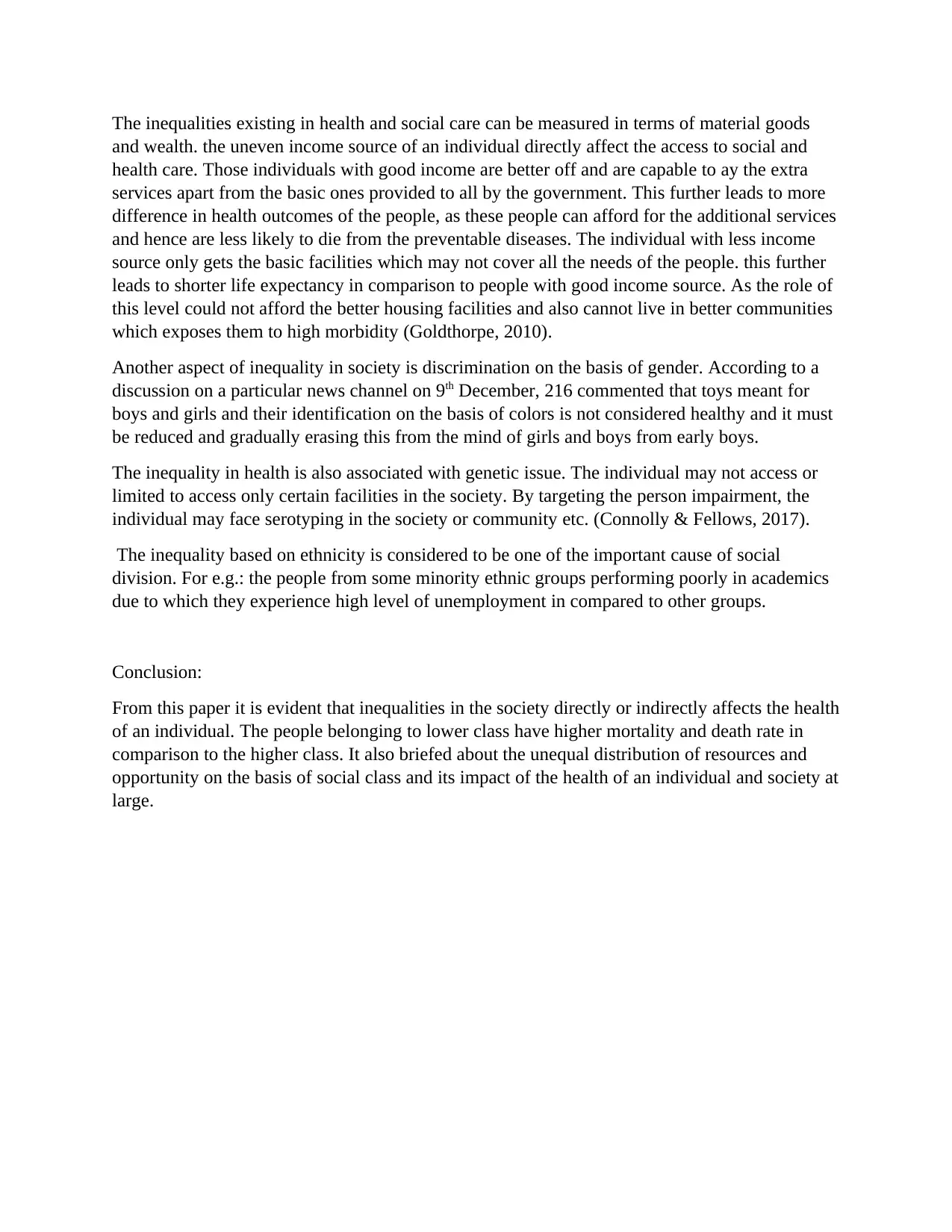
The inequalities existing in health and social care can be measured in terms of material goods
and wealth. the uneven income source of an individual directly affect the access to social and
health care. Those individuals with good income are better off and are capable to ay the extra
services apart from the basic ones provided to all by the government. This further leads to more
difference in health outcomes of the people, as these people can afford for the additional services
and hence are less likely to die from the preventable diseases. The individual with less income
source only gets the basic facilities which may not cover all the needs of the people. this further
leads to shorter life expectancy in comparison to people with good income source. As the role of
this level could not afford the better housing facilities and also cannot live in better communities
which exposes them to high morbidity (Goldthorpe, 2010).
Another aspect of inequality in society is discrimination on the basis of gender. According to a
discussion on a particular news channel on 9th December, 216 commented that toys meant for
boys and girls and their identification on the basis of colors is not considered healthy and it must
be reduced and gradually erasing this from the mind of girls and boys from early boys.
The inequality in health is also associated with genetic issue. The individual may not access or
limited to access only certain facilities in the society. By targeting the person impairment, the
individual may face serotyping in the society or community etc. (Connolly & Fellows, 2017).
The inequality based on ethnicity is considered to be one of the important cause of social
division. For e.g.: the people from some minority ethnic groups performing poorly in academics
due to which they experience high level of unemployment in compared to other groups.
Conclusion:
From this paper it is evident that inequalities in the society directly or indirectly affects the health
of an individual. The people belonging to lower class have higher mortality and death rate in
comparison to the higher class. It also briefed about the unequal distribution of resources and
opportunity on the basis of social class and its impact of the health of an individual and society at
large.
and wealth. the uneven income source of an individual directly affect the access to social and
health care. Those individuals with good income are better off and are capable to ay the extra
services apart from the basic ones provided to all by the government. This further leads to more
difference in health outcomes of the people, as these people can afford for the additional services
and hence are less likely to die from the preventable diseases. The individual with less income
source only gets the basic facilities which may not cover all the needs of the people. this further
leads to shorter life expectancy in comparison to people with good income source. As the role of
this level could not afford the better housing facilities and also cannot live in better communities
which exposes them to high morbidity (Goldthorpe, 2010).
Another aspect of inequality in society is discrimination on the basis of gender. According to a
discussion on a particular news channel on 9th December, 216 commented that toys meant for
boys and girls and their identification on the basis of colors is not considered healthy and it must
be reduced and gradually erasing this from the mind of girls and boys from early boys.
The inequality in health is also associated with genetic issue. The individual may not access or
limited to access only certain facilities in the society. By targeting the person impairment, the
individual may face serotyping in the society or community etc. (Connolly & Fellows, 2017).
The inequality based on ethnicity is considered to be one of the important cause of social
division. For e.g.: the people from some minority ethnic groups performing poorly in academics
due to which they experience high level of unemployment in compared to other groups.
Conclusion:
From this paper it is evident that inequalities in the society directly or indirectly affects the health
of an individual. The people belonging to lower class have higher mortality and death rate in
comparison to the higher class. It also briefed about the unequal distribution of resources and
opportunity on the basis of social class and its impact of the health of an individual and society at
large.
⊘ This is a preview!⊘
Do you want full access?
Subscribe today to unlock all pages.

Trusted by 1+ million students worldwide
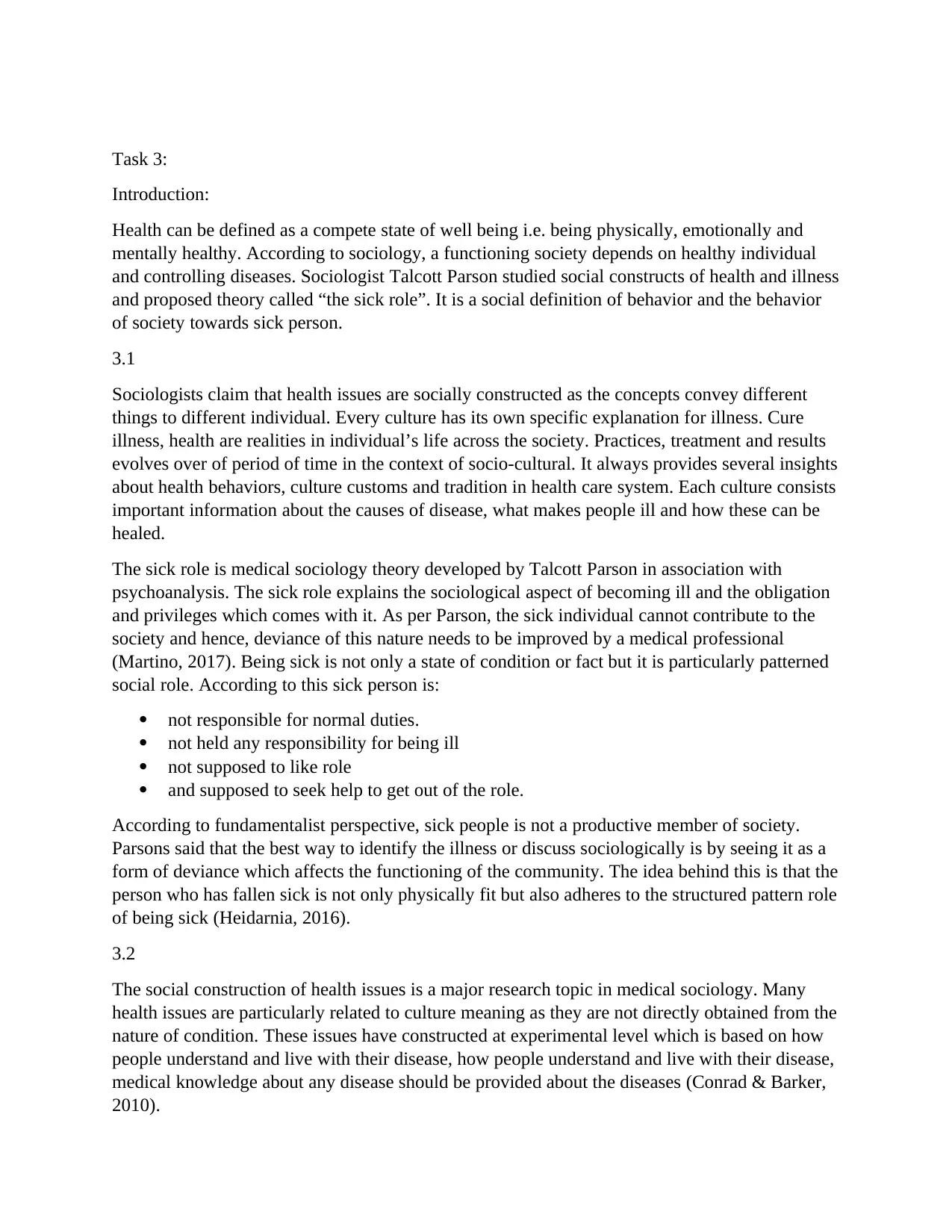
Task 3:
Introduction:
Health can be defined as a compete state of well being i.e. being physically, emotionally and
mentally healthy. According to sociology, a functioning society depends on healthy individual
and controlling diseases. Sociologist Talcott Parson studied social constructs of health and illness
and proposed theory called “the sick role”. It is a social definition of behavior and the behavior
of society towards sick person.
3.1
Sociologists claim that health issues are socially constructed as the concepts convey different
things to different individual. Every culture has its own specific explanation for illness. Cure
illness, health are realities in individual’s life across the society. Practices, treatment and results
evolves over of period of time in the context of socio-cultural. It always provides several insights
about health behaviors, culture customs and tradition in health care system. Each culture consists
important information about the causes of disease, what makes people ill and how these can be
healed.
The sick role is medical sociology theory developed by Talcott Parson in association with
psychoanalysis. The sick role explains the sociological aspect of becoming ill and the obligation
and privileges which comes with it. As per Parson, the sick individual cannot contribute to the
society and hence, deviance of this nature needs to be improved by a medical professional
(Martino, 2017). Being sick is not only a state of condition or fact but it is particularly patterned
social role. According to this sick person is:
not responsible for normal duties.
not held any responsibility for being ill
not supposed to like role
and supposed to seek help to get out of the role.
According to fundamentalist perspective, sick people is not a productive member of society.
Parsons said that the best way to identify the illness or discuss sociologically is by seeing it as a
form of deviance which affects the functioning of the community. The idea behind this is that the
person who has fallen sick is not only physically fit but also adheres to the structured pattern role
of being sick (Heidarnia, 2016).
3.2
The social construction of health issues is a major research topic in medical sociology. Many
health issues are particularly related to culture meaning as they are not directly obtained from the
nature of condition. These issues have constructed at experimental level which is based on how
people understand and live with their disease, how people understand and live with their disease,
medical knowledge about any disease should be provided about the diseases (Conrad & Barker,
2010).
Introduction:
Health can be defined as a compete state of well being i.e. being physically, emotionally and
mentally healthy. According to sociology, a functioning society depends on healthy individual
and controlling diseases. Sociologist Talcott Parson studied social constructs of health and illness
and proposed theory called “the sick role”. It is a social definition of behavior and the behavior
of society towards sick person.
3.1
Sociologists claim that health issues are socially constructed as the concepts convey different
things to different individual. Every culture has its own specific explanation for illness. Cure
illness, health are realities in individual’s life across the society. Practices, treatment and results
evolves over of period of time in the context of socio-cultural. It always provides several insights
about health behaviors, culture customs and tradition in health care system. Each culture consists
important information about the causes of disease, what makes people ill and how these can be
healed.
The sick role is medical sociology theory developed by Talcott Parson in association with
psychoanalysis. The sick role explains the sociological aspect of becoming ill and the obligation
and privileges which comes with it. As per Parson, the sick individual cannot contribute to the
society and hence, deviance of this nature needs to be improved by a medical professional
(Martino, 2017). Being sick is not only a state of condition or fact but it is particularly patterned
social role. According to this sick person is:
not responsible for normal duties.
not held any responsibility for being ill
not supposed to like role
and supposed to seek help to get out of the role.
According to fundamentalist perspective, sick people is not a productive member of society.
Parsons said that the best way to identify the illness or discuss sociologically is by seeing it as a
form of deviance which affects the functioning of the community. The idea behind this is that the
person who has fallen sick is not only physically fit but also adheres to the structured pattern role
of being sick (Heidarnia, 2016).
3.2
The social construction of health issues is a major research topic in medical sociology. Many
health issues are particularly related to culture meaning as they are not directly obtained from the
nature of condition. These issues have constructed at experimental level which is based on how
people understand and live with their disease, how people understand and live with their disease,
medical knowledge about any disease should be provided about the diseases (Conrad & Barker,
2010).
Paraphrase This Document
Need a fresh take? Get an instant paraphrase of this document with our AI Paraphraser
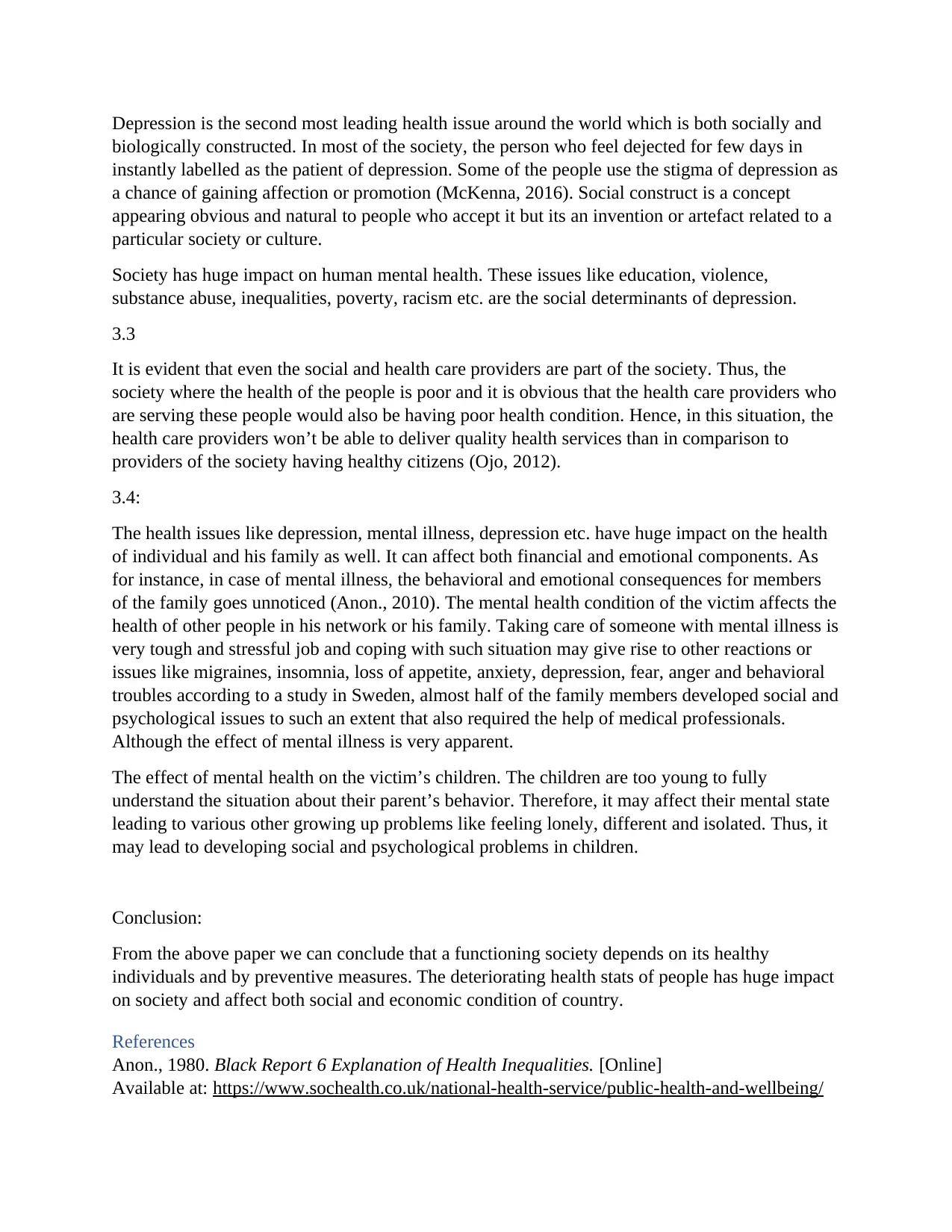
Depression is the second most leading health issue around the world which is both socially and
biologically constructed. In most of the society, the person who feel dejected for few days in
instantly labelled as the patient of depression. Some of the people use the stigma of depression as
a chance of gaining affection or promotion (McKenna, 2016). Social construct is a concept
appearing obvious and natural to people who accept it but its an invention or artefact related to a
particular society or culture.
Society has huge impact on human mental health. These issues like education, violence,
substance abuse, inequalities, poverty, racism etc. are the social determinants of depression.
3.3
It is evident that even the social and health care providers are part of the society. Thus, the
society where the health of the people is poor and it is obvious that the health care providers who
are serving these people would also be having poor health condition. Hence, in this situation, the
health care providers won’t be able to deliver quality health services than in comparison to
providers of the society having healthy citizens (Ojo, 2012).
3.4:
The health issues like depression, mental illness, depression etc. have huge impact on the health
of individual and his family as well. It can affect both financial and emotional components. As
for instance, in case of mental illness, the behavioral and emotional consequences for members
of the family goes unnoticed (Anon., 2010). The mental health condition of the victim affects the
health of other people in his network or his family. Taking care of someone with mental illness is
very tough and stressful job and coping with such situation may give rise to other reactions or
issues like migraines, insomnia, loss of appetite, anxiety, depression, fear, anger and behavioral
troubles according to a study in Sweden, almost half of the family members developed social and
psychological issues to such an extent that also required the help of medical professionals.
Although the effect of mental illness is very apparent.
The effect of mental health on the victim’s children. The children are too young to fully
understand the situation about their parent’s behavior. Therefore, it may affect their mental state
leading to various other growing up problems like feeling lonely, different and isolated. Thus, it
may lead to developing social and psychological problems in children.
Conclusion:
From the above paper we can conclude that a functioning society depends on its healthy
individuals and by preventive measures. The deteriorating health stats of people has huge impact
on society and affect both social and economic condition of country.
References
Anon., 1980. Black Report 6 Explanation of Health Inequalities. [Online]
Available at: https://www.sochealth.co.uk/national-health-service/public-health-and-wellbeing/
biologically constructed. In most of the society, the person who feel dejected for few days in
instantly labelled as the patient of depression. Some of the people use the stigma of depression as
a chance of gaining affection or promotion (McKenna, 2016). Social construct is a concept
appearing obvious and natural to people who accept it but its an invention or artefact related to a
particular society or culture.
Society has huge impact on human mental health. These issues like education, violence,
substance abuse, inequalities, poverty, racism etc. are the social determinants of depression.
3.3
It is evident that even the social and health care providers are part of the society. Thus, the
society where the health of the people is poor and it is obvious that the health care providers who
are serving these people would also be having poor health condition. Hence, in this situation, the
health care providers won’t be able to deliver quality health services than in comparison to
providers of the society having healthy citizens (Ojo, 2012).
3.4:
The health issues like depression, mental illness, depression etc. have huge impact on the health
of individual and his family as well. It can affect both financial and emotional components. As
for instance, in case of mental illness, the behavioral and emotional consequences for members
of the family goes unnoticed (Anon., 2010). The mental health condition of the victim affects the
health of other people in his network or his family. Taking care of someone with mental illness is
very tough and stressful job and coping with such situation may give rise to other reactions or
issues like migraines, insomnia, loss of appetite, anxiety, depression, fear, anger and behavioral
troubles according to a study in Sweden, almost half of the family members developed social and
psychological issues to such an extent that also required the help of medical professionals.
Although the effect of mental illness is very apparent.
The effect of mental health on the victim’s children. The children are too young to fully
understand the situation about their parent’s behavior. Therefore, it may affect their mental state
leading to various other growing up problems like feeling lonely, different and isolated. Thus, it
may lead to developing social and psychological problems in children.
Conclusion:
From the above paper we can conclude that a functioning society depends on its healthy
individuals and by preventive measures. The deteriorating health stats of people has huge impact
on society and affect both social and economic condition of country.
References
Anon., 1980. Black Report 6 Explanation of Health Inequalities. [Online]
Available at: https://www.sochealth.co.uk/national-health-service/public-health-and-wellbeing/
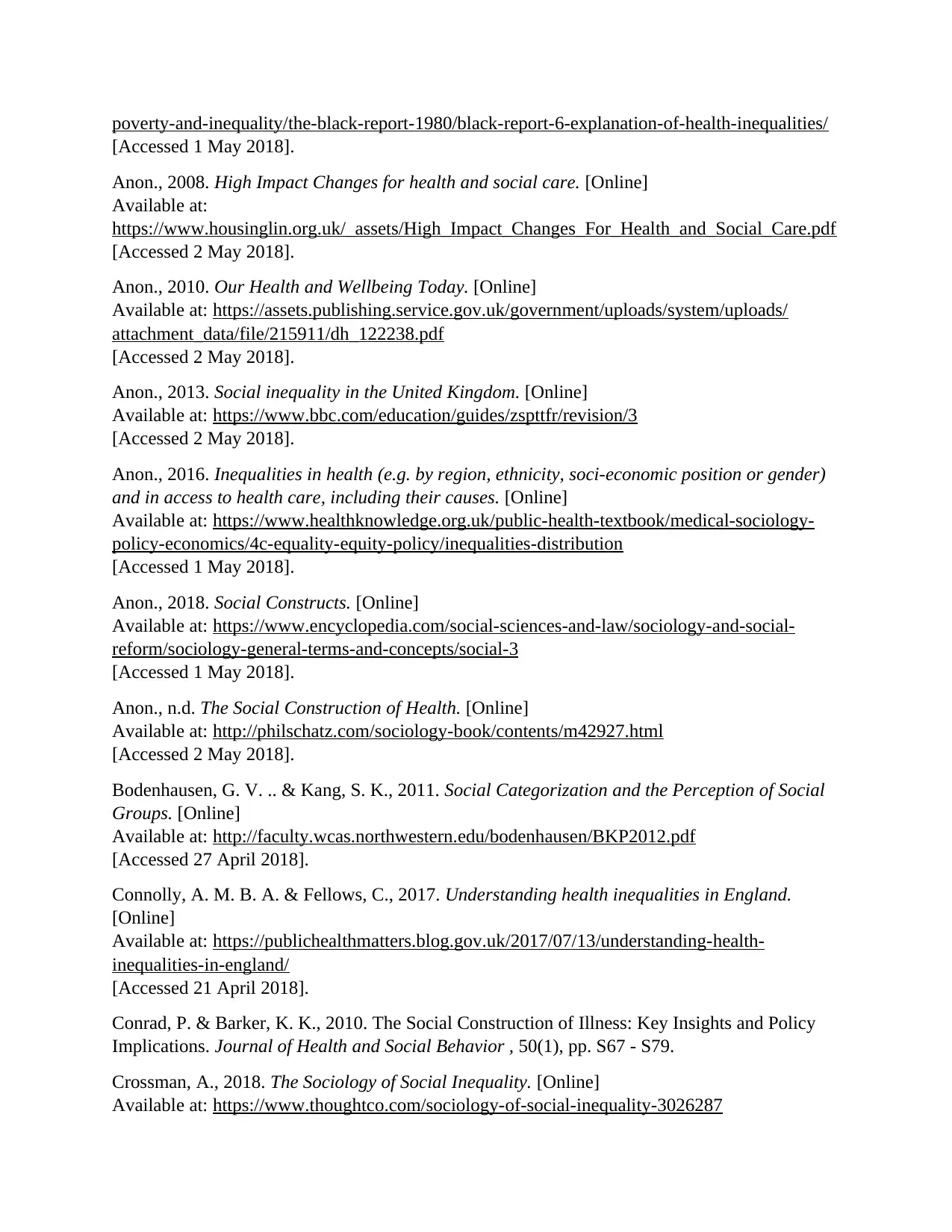
poverty-and-inequality/the-black-report-1980/black-report-6-explanation-of-health-inequalities/
[Accessed 1 May 2018].
Anon., 2008. High Impact Changes for health and social care. [Online]
Available at:
https://www.housinglin.org.uk/_assets/High_Impact_Changes_For_Health_and_Social_Care.pdf
[Accessed 2 May 2018].
Anon., 2010. Our Health and Wellbeing Today. [Online]
Available at: https://assets.publishing.service.gov.uk/government/uploads/system/uploads/
attachment_data/file/215911/dh_122238.pdf
[Accessed 2 May 2018].
Anon., 2013. Social inequality in the United Kingdom. [Online]
Available at: https://www.bbc.com/education/guides/zspttfr/revision/3
[Accessed 2 May 2018].
Anon., 2016. Inequalities in health (e.g. by region, ethnicity, soci-economic position or gender)
and in access to health care, including their causes. [Online]
Available at: https://www.healthknowledge.org.uk/public-health-textbook/medical-sociology-
policy-economics/4c-equality-equity-policy/inequalities-distribution
[Accessed 1 May 2018].
Anon., 2018. Social Constructs. [Online]
Available at: https://www.encyclopedia.com/social-sciences-and-law/sociology-and-social-
reform/sociology-general-terms-and-concepts/social-3
[Accessed 1 May 2018].
Anon., n.d. The Social Construction of Health. [Online]
Available at: http://philschatz.com/sociology-book/contents/m42927.html
[Accessed 2 May 2018].
Bodenhausen, G. V. .. & Kang, S. K., 2011. Social Categorization and the Perception of Social
Groups. [Online]
Available at: http://faculty.wcas.northwestern.edu/bodenhausen/BKP2012.pdf
[Accessed 27 April 2018].
Connolly, A. M. B. A. & Fellows, C., 2017. Understanding health inequalities in England.
[Online]
Available at: https://publichealthmatters.blog.gov.uk/2017/07/13/understanding-health-
inequalities-in-england/
[Accessed 21 April 2018].
Conrad, P. & Barker, K. K., 2010. The Social Construction of Illness: Key Insights and Policy
Implications. Journal of Health and Social Behavior , 50(1), pp. S67 - S79.
Crossman, A., 2018. The Sociology of Social Inequality. [Online]
Available at: https://www.thoughtco.com/sociology-of-social-inequality-3026287
[Accessed 1 May 2018].
Anon., 2008. High Impact Changes for health and social care. [Online]
Available at:
https://www.housinglin.org.uk/_assets/High_Impact_Changes_For_Health_and_Social_Care.pdf
[Accessed 2 May 2018].
Anon., 2010. Our Health and Wellbeing Today. [Online]
Available at: https://assets.publishing.service.gov.uk/government/uploads/system/uploads/
attachment_data/file/215911/dh_122238.pdf
[Accessed 2 May 2018].
Anon., 2013. Social inequality in the United Kingdom. [Online]
Available at: https://www.bbc.com/education/guides/zspttfr/revision/3
[Accessed 2 May 2018].
Anon., 2016. Inequalities in health (e.g. by region, ethnicity, soci-economic position or gender)
and in access to health care, including their causes. [Online]
Available at: https://www.healthknowledge.org.uk/public-health-textbook/medical-sociology-
policy-economics/4c-equality-equity-policy/inequalities-distribution
[Accessed 1 May 2018].
Anon., 2018. Social Constructs. [Online]
Available at: https://www.encyclopedia.com/social-sciences-and-law/sociology-and-social-
reform/sociology-general-terms-and-concepts/social-3
[Accessed 1 May 2018].
Anon., n.d. The Social Construction of Health. [Online]
Available at: http://philschatz.com/sociology-book/contents/m42927.html
[Accessed 2 May 2018].
Bodenhausen, G. V. .. & Kang, S. K., 2011. Social Categorization and the Perception of Social
Groups. [Online]
Available at: http://faculty.wcas.northwestern.edu/bodenhausen/BKP2012.pdf
[Accessed 27 April 2018].
Connolly, A. M. B. A. & Fellows, C., 2017. Understanding health inequalities in England.
[Online]
Available at: https://publichealthmatters.blog.gov.uk/2017/07/13/understanding-health-
inequalities-in-england/
[Accessed 21 April 2018].
Conrad, P. & Barker, K. K., 2010. The Social Construction of Illness: Key Insights and Policy
Implications. Journal of Health and Social Behavior , 50(1), pp. S67 - S79.
Crossman, A., 2018. The Sociology of Social Inequality. [Online]
Available at: https://www.thoughtco.com/sociology-of-social-inequality-3026287
⊘ This is a preview!⊘
Do you want full access?
Subscribe today to unlock all pages.

Trusted by 1+ million students worldwide
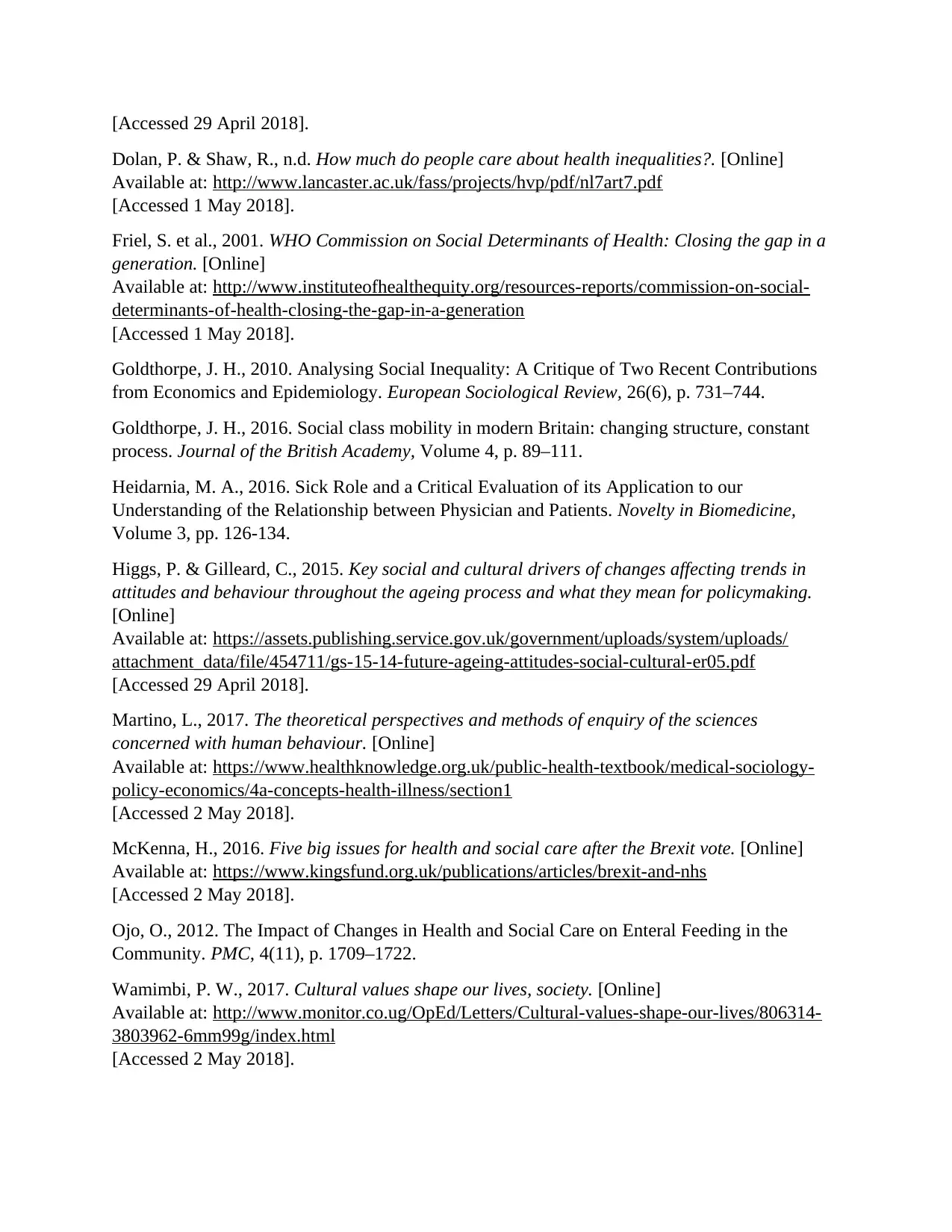
[Accessed 29 April 2018].
Dolan, P. & Shaw, R., n.d. How much do people care about health inequalities?. [Online]
Available at: http://www.lancaster.ac.uk/fass/projects/hvp/pdf/nl7art7.pdf
[Accessed 1 May 2018].
Friel, S. et al., 2001. WHO Commission on Social Determinants of Health: Closing the gap in a
generation. [Online]
Available at: http://www.instituteofhealthequity.org/resources-reports/commission-on-social-
determinants-of-health-closing-the-gap-in-a-generation
[Accessed 1 May 2018].
Goldthorpe, J. H., 2010. Analysing Social Inequality: A Critique of Two Recent Contributions
from Economics and Epidemiology. European Sociological Review, 26(6), p. 731–744.
Goldthorpe, J. H., 2016. Social class mobility in modern Britain: changing structure, constant
process. Journal of the British Academy, Volume 4, p. 89–111.
Heidarnia, M. A., 2016. Sick Role and a Critical Evaluation of its Application to our
Understanding of the Relationship between Physician and Patients. Novelty in Biomedicine,
Volume 3, pp. 126-134.
Higgs, P. & Gilleard, C., 2015. Key social and cultural drivers of changes affecting trends in
attitudes and behaviour throughout the ageing process and what they mean for policymaking.
[Online]
Available at: https://assets.publishing.service.gov.uk/government/uploads/system/uploads/
attachment_data/file/454711/gs-15-14-future-ageing-attitudes-social-cultural-er05.pdf
[Accessed 29 April 2018].
Martino, L., 2017. The theoretical perspectives and methods of enquiry of the sciences
concerned with human behaviour. [Online]
Available at: https://www.healthknowledge.org.uk/public-health-textbook/medical-sociology-
policy-economics/4a-concepts-health-illness/section1
[Accessed 2 May 2018].
McKenna, H., 2016. Five big issues for health and social care after the Brexit vote. [Online]
Available at: https://www.kingsfund.org.uk/publications/articles/brexit-and-nhs
[Accessed 2 May 2018].
Ojo, O., 2012. The Impact of Changes in Health and Social Care on Enteral Feeding in the
Community. PMC, 4(11), p. 1709–1722.
Wamimbi, P. W., 2017. Cultural values shape our lives, society. [Online]
Available at: http://www.monitor.co.ug/OpEd/Letters/Cultural-values-shape-our-lives/806314-
3803962-6mm99g/index.html
[Accessed 2 May 2018].
Dolan, P. & Shaw, R., n.d. How much do people care about health inequalities?. [Online]
Available at: http://www.lancaster.ac.uk/fass/projects/hvp/pdf/nl7art7.pdf
[Accessed 1 May 2018].
Friel, S. et al., 2001. WHO Commission on Social Determinants of Health: Closing the gap in a
generation. [Online]
Available at: http://www.instituteofhealthequity.org/resources-reports/commission-on-social-
determinants-of-health-closing-the-gap-in-a-generation
[Accessed 1 May 2018].
Goldthorpe, J. H., 2010. Analysing Social Inequality: A Critique of Two Recent Contributions
from Economics and Epidemiology. European Sociological Review, 26(6), p. 731–744.
Goldthorpe, J. H., 2016. Social class mobility in modern Britain: changing structure, constant
process. Journal of the British Academy, Volume 4, p. 89–111.
Heidarnia, M. A., 2016. Sick Role and a Critical Evaluation of its Application to our
Understanding of the Relationship between Physician and Patients. Novelty in Biomedicine,
Volume 3, pp. 126-134.
Higgs, P. & Gilleard, C., 2015. Key social and cultural drivers of changes affecting trends in
attitudes and behaviour throughout the ageing process and what they mean for policymaking.
[Online]
Available at: https://assets.publishing.service.gov.uk/government/uploads/system/uploads/
attachment_data/file/454711/gs-15-14-future-ageing-attitudes-social-cultural-er05.pdf
[Accessed 29 April 2018].
Martino, L., 2017. The theoretical perspectives and methods of enquiry of the sciences
concerned with human behaviour. [Online]
Available at: https://www.healthknowledge.org.uk/public-health-textbook/medical-sociology-
policy-economics/4a-concepts-health-illness/section1
[Accessed 2 May 2018].
McKenna, H., 2016. Five big issues for health and social care after the Brexit vote. [Online]
Available at: https://www.kingsfund.org.uk/publications/articles/brexit-and-nhs
[Accessed 2 May 2018].
Ojo, O., 2012. The Impact of Changes in Health and Social Care on Enteral Feeding in the
Community. PMC, 4(11), p. 1709–1722.
Wamimbi, P. W., 2017. Cultural values shape our lives, society. [Online]
Available at: http://www.monitor.co.ug/OpEd/Letters/Cultural-values-shape-our-lives/806314-
3803962-6mm99g/index.html
[Accessed 2 May 2018].
Paraphrase This Document
Need a fresh take? Get an instant paraphrase of this document with our AI Paraphraser

1 out of 11
Related Documents
Your All-in-One AI-Powered Toolkit for Academic Success.
+13062052269
info@desklib.com
Available 24*7 on WhatsApp / Email
![[object Object]](/_next/static/media/star-bottom.7253800d.svg)
Unlock your academic potential
Copyright © 2020–2025 A2Z Services. All Rights Reserved. Developed and managed by ZUCOL.





